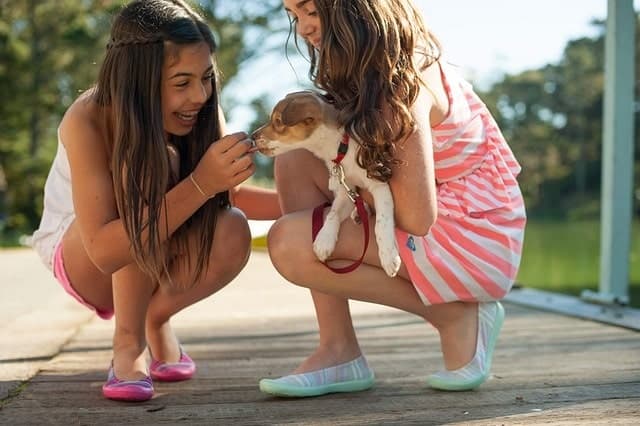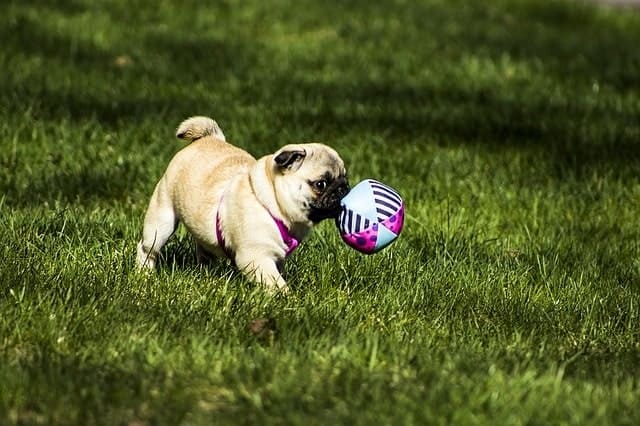You want your new puppy to grow into a healthy, well-mannered, and loveable constant companion, but it’s not something that just happens without effort. Raising a puppy is hard work, takes time and patience, and is also well worth the effort you put in. If you’re not sure where to start or are having some questions along the way, this article covers all the essential information you need on how to raise a puppy.
How to Raise a Happy Puppy
1. What Should a Puppy Eat?

First and foremost, the food that you feed your puppy should be packed with plenty of energy. That means healthy fats and protein in order to keep their batteries charged for a day full of play. Protein should be around 30%, fat around 15-18%.1 It’s important that your puppy’s diet contains enough fat to fuel them but not so much that it increases their risk of obesity or orthopedic problems.2
Puppy food should also contain DHA, a fatty acid that plays a major role in the development of the brain and vision.3 DHA is a natural fatty acid that’s found in their mother’s milk and should remain in high amounts during those early days of puppyhood until they reach adulthood.4
Large and extra-large breed puppies have special diet considerations. If you happen to have one of these puppies, you’ll want to feed them food that’s specially formulated for large breeds. These diets are restricted in calcium and phosphorus in order to slow bony growth.5 This is necessary to prevent growth deformities that may require extensive treatment.6
The most common question about feeding puppies is when to switch to an adult formula. Unfortunately, there’s no set date that you can mark on your calendar. Dogs reach adulthood when they stop growing, which depends on a dog’s breed and weight. In general, small and medium-sized pups are considered adults between nine and 12 months of age, with smaller breeds being on the earlier side. Large and giant breeds typically don’t quit growing until between 18-24 months. For a more accurate estimate, the AAHA’s Canine Life Stage Calculator calculates your dog’s life stage based on their breed and current age. Still not sure? Speak to your veterinarian for a customized plan for your pup.
2. How to Train a Puppy

Training your new puppy starts on day one; it’s never too early. With that in mind, it’s also important to remember that there’s a learning curve for every puppy. It may take some longer than others to master what you’re trying to teach them. Puppy training falls into a few basic categories:
- Basic commands: Whether or not you’re looking for a puppy that will play dead when you shoot them or dance around to a specific song, every pup should learn some basic commands.7 Sit, stay, down, and come are important ones to have in your puppy’s back pocket. Not only do they help create a well-mannered dog, but they’re also important for your dog’s safety.
- Potty training: Perhaps the most sought-after advice for raising a puppy pertains to potty training. We all get tired of cleaning up messes and dream of the day when our puppy asks to be let outside. Being patient and establishing a routine are your best friends for this process.
- Socialization: Socialization is crucial for every dog. A dog that is used to meeting new people and critters is more likely to be calm and accepting of everything going on around them.8 Once they’ve had their series of vaccinations, taking them to the dog park, obedience class, a neighbor’s house, etc. is encouraged.
- Leash training: Walking on a leash is an important skill for your puppy to master. A leash gives you control of your dog and helps to keep them safe. Your pup should always be on a leash when out of a fenced area.
With any puppy training, positive reinforcement will help your puppy develop into a trusting, happy, and obedient dog.9
3. How to Exercise a Puppy

No doubt about it, puppies have a lot of energy. Puppies that are given positive outlets to burn that energy tend to sleep better and are healthier and happier. Your puppy needs two kinds of exercise daily: physical and mental.
Physical exercise should be varied. Don’t rely on a walk around the block every day. Try to shake it up with different routes, runs, games, and playdates. Toys are great additions to exercise and can also allow you to participate, which helps to strengthen your bond with your pup.10
Mental stimulation is necessary to keep your puppy’s wits sharp and to keep them interested in their surroundings.11 Games of fetch or hide and seek are great, as well as interactive toys that have your pup solve a puzzle in order to get a treat. Mentally stimulating games are great options for when you can’t be with your puppy to stave off boredom and separation anxiety.
Even though it may seem like your pup can do it all, it’s important to remember that puppies are growing, and with that comes wiggly-wobbly joints. This means you need to be mindful of your puppy’s activities to ensure your pup doesn’t injure those joints.12 Don’t ask them to do too much jumping or twisting, such as when catching a frisbee. You may also want to look into getting a dog ramp to help them get in and out of the car or up onto the bed to save some wear and tear on those developing joints.
Final Thoughts
Raising a puppy comes with a large dose of joy and excitement, along with a little frustration and uncertainty. Establishing care with a trusted veterinarian is a necessity in raising a puppy. Your veterinarian becomes a partner in your puppy’s health and well-being, and they can help address some of the worries and questions that you may have. Above all, raising a puppy is supposed to be fun, so don’t forget to enjoy the good moments and laugh off the challenging ones.
- Williams K, Downing R. Feeding growing puppies. Vcahospitals.com. Accessed February 9, 2021.
- Frye CW, Shmalberg JW, Wakshlag JJ. Obesity, Exercise and Orthopedic Disease. Vet Clin North Am Small Anim Pract. 2016;46(5):831-841. doi:10.1016/j.cvsm.2016.04.006
- Oke S. Boosting Puppy Brains for Trainability with Omega-3 Fatty Acids. Akc.org. Published May 19, 2016. Accessed February 9, 2021.
- Heinze CR, Freeman LM, Martin CR, Power ML, Fascetti AJ. Comparison of the nutrient composition of commercial dog milk replacers with that of dog milk. J Am Vet Med Assoc. 2014;244(12):1413-1422. doi:10.2460/javma.244.12.1413
- Kerby V. Giant Expectations: Nutrition for the Large-Breed Puppy. Todaysveterinarynurse.com. Accessed February 9, 2021.
- Kane E. Developmental orthopedic disease in large-breed puppies. Dvm360.com. Published February 4, 2013. Accessed February 9, 2021.
- Lunchick P. Teach Your Puppy These 5 Basic Cues. Akc.org. Published February 3, 2021. Accessed February 9, 2021.
- Confident Canine: Why Training and Socialization Matters for all Dogs. Myarlingtonvet.com. Published August 15, 2017. Accessed February 9, 2021.
- Todd Z. What is Positive Reinforcement in Dog Training? Companionanimalpsychology.com. Published February 1, 2017. Accessed February 9, 2021.
- Kansas State University. Vet says owners should exercise with their dogs based on specific needs to prevent obesity. Sciencedaily.com. Published September 10, 2009. Accessed February 9, 2021.
- Maintaining pet health: Mental stimulation matters to your family pet. Foxvalleyanimalhospital.com.au. Published April 24, 2018. Accessed February 9, 2021.
- Flocken M. Exercise in puppies and young dogs – how much is healthy, and what is the right kind? Flexi-northamerica.com. Published June 16, 2019. Accessed February 9, 2021.
















